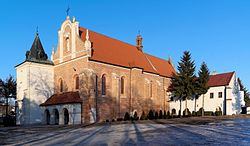Nowy Korczyn
Nowy Korczyn | |
|---|---|
Town | |
 Saint Stanislaus Church | |
| Coordinates: 50°17′57″N 20°48′32″E / 50.29917°N 20.80889°E | |
| Country | |
| Voivodeship | |
| County | Busko |
| Gmina | Nowy Korczyn |
| Population | 1,032 |
Nowy Korczyn [ˈnɔvɨ ˈkɔrt͡ʂɨn] is a small town in Busko County, Świętokrzyskie Voivodeship, in south-central Poland. It is the seat of the gmina (administrative district) called Gmina Nowy Korczyn. It lies in Lesser Poland, approximately 20 kilometres (12 mi) south of Busko-Zdrój and 67 km (42 mi) south of the regional capital Kielce.[1] It is located close to the confluence of the Nida and the Vistula rivers. Nowy Korczyn was a town from 1258 to 1869.
History
Until it lost its city rights[
In the
Since Nowy Korczyn is located in the center of Lesser Poland, the town was frequently visited by Polish rulers. It was an important political and judicial center of the province, here Lesser Poland's
In the 15th century, several important meetings and events took place at the Nowy Korczyn castle. In 1461, King
In the
In 1474 most of Nowy Korczyn burned in a fire, after which the town was released from its tax duties for 12 years. In 1549, King
The importance of the town diminished in the early 17th century, after the capital of the Commonwealth was moved from Kraków to Warsaw. In 1606, during the
In September 1914, Nowy Korczyn was the area where Polish Legions operated. Here the headquarters of Józef Piłsudski was briefly stationed, and after the war, the village belonged to Kielce Voivodeship. In the Second Polish Republic it remained a poor village, with a significant Jewish population. In 1942, the Jews of Nowy Korczyn were deported to and murder in Treblinka.[2] Concerning the deportation of the Jews of Nowy Korczyn, a witness stated the following: "In the night of November 2. in 1942 Nowy Korczyn was surrounded by the German military and two Ukrainian units. The Jews of the town were chased to the town square - or rather a market place in the centre of the town. There could have been 2000 Jews or 3000 or more, I don't know, different figures are mentioned. However, all the Jews of Nowy Korczyn were deported [...]".[3] In 1944, during Operation Tempest, units of the Home Army attacked German police post in Nowy Korczyn. The synagogue of Nowy Korczyn has been under preservation since 2014.[4]
Transport
Nowy Korczyn does not have a train station. The village is located at the intersection of National Road Nr 79 (
Points of interest
- complex of former Franciscan abbey (1257), with a Gothic church of St. Stanislaus,
- Gothic - Renaissance church of Holy Trinity (16th century),
- ruins of the 18th century synagogue,
- house of Jan Długosz (16th century), which housed the Nowy Korczyn Protestant Academy,
- houses from the 16th, 17th and 18th century,
- 19th century Russian Cemetery, where Russian civil servants and soldiers were buried.
References
- ^ "Central Statistical Office (GUS) - TERYT (National Register of Territorial Land Apportionment Journal)" (in Polish). 2008-06-01.
- ^ "Belzec: Stepping Stone to Genocide - Appendix 2".
- ^ "History".
- ^ Nowy Korczyn Synagogue before and after. Jewish-heritage-europe.eu.
- ^ "Prom rzeczny (50.290066,20.801754)" [River ferry (50.290066,20.801754)]. Google Maps. Google Maps. Retrieved 2012-01-29.


